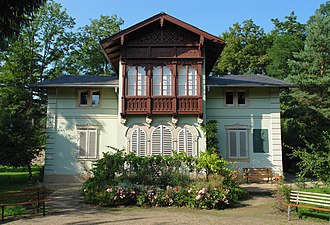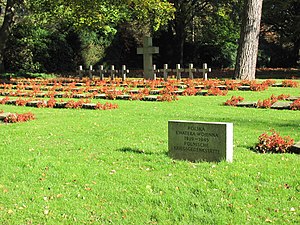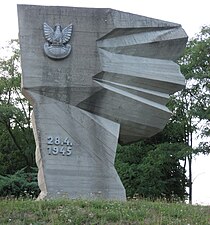Poles in Germany
 Rodło, a symbol of the Polish minority in Germany, originally used by the Union of Poles in Germany. | |
| Total population | |
|---|---|
| 2,100,022 (2020)[1] | |
| Languages | |
| Polish, German, Silesian, Kashubian | |
| Religion | |
| 75.5% Roman Catholic, 13.8% non-religious, 8.0% Protestantism[2] | |
| Related ethnic groups | |
| Poles, Germans, Kashubians, Poles in the United States |
Poles in Germany (German: Polen) are the second largest Polish diaspora (Polonia) in the world and the biggest in Europe. Estimates of the number of Poles living in Germany vary from 2 million[3][4][5] to about 3 million people living that might be of Polish descent. Their number has quickly decreased over the years, and according to the latest census, there are approximately 866,690 Poles in Germany.[1] The main Polonia organisations in Germany are the Union of Poles in Germany and Congress of Polonia in Germany. Polish surnames are relatively common in Germany, especially in the Ruhr area (Ruhr Poles).
History
[edit]Early history
[edit]
Some parts of modern eastern Germany formed part of medieval Poland, i.e. the western Lubusz Land, Lusatia and Hither Pomerania, before passing under the suzerainty of various German states. Since the Middle Ages, Poles have arrived to German states in small numbers. A number of Polish princesses married various German princes and thus resided in present-day Germany. The Polish Nation was one of the four recognized nations of the Leipzig University since its establishment in the 15th century, with many Poles attending it throughout the centuries.
Poles settled in present-day Germany more numerously during the 18th-century Polish-Saxon union e.g. in Dresden and Leipzig.[6] Dresden was named Royal-Polish Residential City after Augustus II the Strong became King of Poland in 1697.[citation needed] Contacts between the Poles and Sorbs in Lusatia, since 1635 ruled by Saxony, and previously also ruled by Poland in the Middle Ages, resumed, coincidentally at a time when the Sorbian national revival began and resistance to Germanization emerged, and Poles influenced the Sorbs' national and cultural activities.[7] Some Polish nobles owned estates in Lusatia.[8]
Late modern period
[edit]
Since the Partitions of Poland in 1772, 1793 and 1795 and Poland's partial incorporation into Prussia, a large Polish ethnic group existed inside Prussia's borders, especially in the new provinces of Posen and West Prussia. Prussia enacted anti-Polish policies aimed at the Germanisation of Poles, whereas Saxony maintained a friendly policy toward Poles, both already settled as well as refugees from partitioned Poland. In 1793, preparations for the Polish Kościuszko Uprising were initiated by Tadeusz Kościuszko in Dresden in response to the Second Partition of Poland.[9] Many Poles fled to Saxony from the Russian Partition of Poland after unsuccessful Polish uprisings, including the artistic and political elite, such as composer Frédéric Chopin, war hero Józef Bem and writer Adam Mickiewicz.[10] Mickiewicz wrote one of his greatest works, Dziady, Part III, in Dresden.[10]
Between 1870 and 1914, some 3.5 million Poles have emigrated to Germany, including 1.2 million in internal migration from Polish territories under German rule, 1.2 million from the Russian Partition of Poland and 1.1 million from the Austrian Partition of Poland.[11] Since the right to establish national or ethnic political organizations was restricted, the first Polish organizations in Germany were cultural organizations focused on protecting Polish identity and maintaining ties to Polish culture.[11]

During the late 19th century rapid industrialisation in the Ruhr region attracted about 500,000 Poles, especially from East Prussia, West Prussia, Greater Poland, and Silesia, including Kashubians and Masurians.[12] They comprised about 30% of the Ruhr area population by 1910. Participants in this migration are called the Ruhr Poles. Ruhr Poles formed a thriving Polish community and established numerous Polish organizations, bookstores, companies, co-operative shops, banks, sports clubs, singing clubs, and local Polish-language newspapers were issued in Bochum, Dortmund and Herne.[13][14][15][16] The main center of the Polish community of the Ruhr area was Bochum, and since 1905, many organizations and enterprises were based at Am Kortländer Street,[15] which was hence nicknamed "Little Warsaw".[16] By 1914, over 1,000 Polish organizations were formed in the Ruhr with over 111,000 members.[12] Polish candidates won 35 seats in the Rhine Province parliament in the 1914 elections.[17] The two most successful and popular football clubs of the Ruhr region, FC Schalke 04 and Borussia Dortmund, were co-founded by Poles,[18] and the former was even mockingly called the Polackenverein ("Polack club") by the Germans because of its many players of Polish origin.[19]
Several Polish noble families had residences in Berlin. The Radziwiłł Palace became the seat of the Reich Chancellery in the 1870s, whereas the Raczyński Palace was demolished in the 1880s to make space for the German parliament building.
After 1870, the Poles were under an increasing pressure of Germanisation, and the Kulturkampf attacked their Catholic Church. Most Catholic bishops were imprisoned or exiled. The teaching language which had previously been Polish in the predominantly Polish-speaking areas in Prussia was replaced by German as teaching language, even in religious education where Polish priests were replaced by German teachers. However, these Germanisation policies were not at all successful. In contrast, it led to the political awakening of many Poles and to the establishment of a wealth of Polish economic, political and cultural associations which were aimed at preserving Polish culture and Polish interests, especially in the Province of Posen and in the Ruhr area. In the Ruhr, Germany banned the use of the Polish language in schools (since 1873), in mines (since 1899), and at public gatherings (since 1908).[15] Polish publishing houses and bookstores were often searched by the German police, and Polish patriotic books and publications were confiscated.[20] In 1909, the Central Office for Monitoring the Polish Movement in the Rhine-Westphalian Industrial Districts (Zentralstelle fur Uberwachung der Polenbewegung im Rheinisch-Westfalischen Industriebezirke) was established by the Germans in Bochum.[21][22] The policy of forced cultural Germanisation alienated large parts of the Polish-speaking population against the German authorities and produced nationalistic sentiments on both sides.
Interbellum and World War II
[edit]
After the First World War, the predominantly Polish provinces had to be ceded to the newly created Polish Republic. Polish-speaking minorities remained especially in Upper Silesia and parts of East Prussia. During the 1922 to 1937 term of the German-Polish Accord on Upper Silesia (Geneva Agreement),[23] signed in Geneva on 15 May 1922, German nationals of Polish ethnicity in Upper Silesia had judicial status as a national minority[24] under the auspices of the League of Nations (likewise the Poles of German ethnicity in the Polish Silesian Voivodeship). In 1922, various Polish organizations were unified into the Union of Poles in Germany, the chief organization of Poles in Germany to this day, by the initiative of which the Association of National Minorities in Germany was formed in 1924, which also gathered Danes, Sorbs, Frisians and Lithuanians.[25]
After the rise of the Nazis, all Polish activities were systematically constrained, since mid-1937 also in Upper Silesia. However, in August 1939, the leadership of the Polish community was arrested and interned in the Nazi concentration camps of Sachsenhausen and Buchenwald. On 7 September 1939, shortly after the outbreak of World War II, the Nazi government of the Third Reich stripped the Polish community in Germany of its minority status. This was formally confirmed by Hermann Göring's decree of 27 February 1940. In September 1939, the Gestapo carried out arrests of prominent Poles in Berlin, Dresden, Leipzig, Bremen, Hamburg, Hanover and the Ruhr.[26] Germany also closed Polish organizations, newspapers, printing shops, schools, libraries and enterprises, and seized their properties, which was formally sanctioned post factum by Nazi decrees of 1940.[27] During the war, many Poles were deported to forced labour in Germany.
After the end of World War II, there were over 1.7 million Polish displaced persons in Allied-occupied Germany, including 700,000 in the Soviet occupation zone, 540,000 in the British occupation zone, 400,000 in the American occupation zone and 68,000 in the French occupation zone.[28]
Today
[edit]Today the German government does not recognise German nationals of Polish ethnicity as a national minority. As a result, according to Polish agencies, Germany is not recognising the right of self-determination of the Polish minority in Germany.[29] After Poland joined the European Union, several organisations of Poles in Germany attempted to restore the pre-war official minority status, particularly claiming that the Nazi decree is void. While the initial memorandum to the Bundestag remained unanswered, in December 2009 the Minority Commission of the Council of Europe obliged the German government to formally respond to the demands within four months.[citation needed]
The position of the German government is that after the German territorial losses after World War II, the current Polish minority has no century-old roots in the remaining German territory, because Germany lost all the territories where people of German and Polish ethnicity overlapped. Since they are therefore only recent immigrants, they do not fulfill the requirements of a national minority according to the Framework Convention for the Protection of National Minorities and the Treaty of Good Neighbourship. Being German citizens, they still retain all civil and political rights every German citizen possesses, and therefore can voice their will in the political system.[30]
About 10,000 Polish citizens have recently moved to German localities along the Polish-German border, depopulated after the unification of Germany.[31][32] Poles live especially within the Szczecin metropolitan area, which, although centered on the Polish city of Szczecin, also extends to the municipalities on the German side of the border, such as Gartz and Löcknitz.
Population distribution
[edit]

Data of 2011:[33]
| State | Number of Poles | % of State population | % of Poles in Germany |
|---|---|---|---|
| North Rhine-Westphalia | 786,480 | 4.5 | 39.2 |
| Bavaria | 202,220 | 1.6 | 10.1 |
| Baden-Württemberg | 202,210 | 1.9 | 10.1 |
| Lower Saxony | 201,620 | 2.6 | 10.1 |
| Hessen | 163,200 | 2.7 | 8.1 |
| Berlin | 101,080 | 3.1 | 5.0 |
| Rhineland-Palatinate | 88,860 | 2.2 | 4.4 |
| Hamburg | 71,260 | 4.2 | 3.6 |
| Schleswig-Holstein | 55,510 | 2.0 | 2.8 |
| Brandenburg | 27,940 | 1.1 | 1.4 |
| Bremen | 26,270 | 4.0 | 1.3 |
| Saxony | 25,700 | 0.6 | 1.3 |
| Saarland | 19,870 | 2.0 | 1.0 |
| Mecklenburg-Vorpommern | 13,250 | 0.8 | 0.7 |
| Saxony-Anhalt | 10,790 | 0.5 | 0.5 |
| Thuringia | 10,140 | 0.5 | 0.5 |
| Total | 2,006,410 | 2.52 | 100.0 |

| Number of Poles in larger cities | |||||||||
| # | City | People | |||||||
|---|---|---|---|---|---|---|---|---|---|
| 1. | Berlin | 56,573 | |||||||
| 2. | Hamburg | 23,310 | |||||||
| 3. | Munich | 18,639 | |||||||
| 4. | Frankfurt | 12,174 | |||||||
| 5. | Dortmund | 10,138 | |||||||
| 6. | Cologne | 9,766 | |||||||
| 7. | Bremen | 9,455 | |||||||
| 8. | Düsseldorf | 9,316 | |||||||
| 9. | Hanover | 8,259 | |||||||
| 10. | Essen | 6,952 | |||||||
| 11. | Bonn | 6,879 | |||||||
| 12. | Nuremberg | 6,670 | |||||||
| 13. | Mannheim | 6,595 | |||||||
| 14. | Wuppertal | 5,870 | |||||||
| 15. | Duisburg | 5,423 | |||||||
| 16. | Leipzig | 5,219 | |||||||
| 17. | Wiesbaden | 4,648 | |||||||
| 18. | Gelsenkirchen | 4,517 | |||||||
| 19. | Krefeld | 4,473 | |||||||
| 20. | Offenbach | 4,112 | |||||||
Image gallery
[edit]- Kraszewski-Museum in Dresden
- Józef Poniatowski memorial in Leipzig
- Polish Soldiers' Quarter of the Ohlsdorf Cemetery in Hamburg
- Saint Anne church of the Polish Catholic Mission in Dortmund
- Monument to Polish soldiers in Crostwitz (Chrósćicy)
- German-Polish Gymnasium and Lyceum in Löcknitz
- Polish Shop in Berlin
- Former Polish Catholic church in Wolgast
- Demolished palaces of Polish nobility
- Moszyńska Palace in Dresden
- Potocki Palace in Hamburg
- Jabłonowski Palace in Leipzig
- Raczyński Palace in Berlin
Notable individuals
[edit]See also
[edit]- Germany–Poland relations
- German minority in Poland
- Union of Poles in Germany
- List of notable Germans of Polish origin
- Association of National Minorities in Germany
References
[edit]- ^ a b "Anzahl der Ausländer in Deutschland nach Herkunftsland in den Jahren 2015 und 2016". statista (in German).
- ^ "Zensusdatenbank – Ergebnisse des Zensus 2011". Retrieved 25 April 2015.
- ^ "Zensusdatenbank – Ergebnisse des Zensus 2011". Retrieved 25 April 2015.
- ^ Wspólnota Polska. "Stowarzyszenie Wspólnota Polska". Archived from the original on 9 May 2015. Retrieved 25 April 2015.
- ^ "Raport o sytuacji Polonii i Polaków za granicą 2012". Ministerstwo Spraw Zagranicznych. 2013. p. 177. Retrieved 27 November 2013.
- ^ "Muzeum Emigracji w Gdyni". Retrieved 26 November 2014.
- ^ Matyniak 1968, p. 241.
- ^ Matyniak 1968, p. 243.
- ^ "Insurekcja Kościuszkowska - ostatnia próba ratowania Rzeczpospolitej". Dzieje.pl (in Polish). Retrieved 19 July 2024.
- ^ a b Sadowski, Aleksander Marek (2022). "Sachsen und Polen – Tausend Jahre Nachbarschaft / Polska i Saksonia – tysiąc lat sąsiedztwa". Polonus (in German and Polish). No. 5. Ostritz. p. 39. ISSN 2701-6285.
- ^ a b Nowosielski 2011, p. 29.
- ^ a b Osses 2024, pp. 47, 49.
- ^ Chojnacki 1981, pp. 201, 203–205.
- ^ Nowosielski 2011, p. 30.
- ^ a b c "Bochum as the center of the Polish movement". Retrieved 20 July 2024.
- ^ a b ""Klein Warschau" an der Ruhr" (in German). Retrieved 20 July 2024.
- ^ Osses 2024, pp. 47, 50.
- ^ "Polacy". Borussia.com.pl (in Polish). Retrieved 20 July 2024.
- ^ "Nazizm, wojna i klub Polaczków – historia Adolfa Urbana". Historia.org.pl (in Polish). Retrieved 20 July 2024.
- ^ Chojnacki 1981, pp. 202–203.
- ^ Chojnacki 1981, p. 202.
- ^ Osses 2024, pp. 48, 50.
- ^ Cf. "Deutsch-polnisches Abkommen über Oberschlesien“ (Oberschlesien-Abkommen, OSA) of 15 May 1922, in: Reichsgesetzblatt, 1922, part II, pp. 238ff.
- ^ Rak, Krzysztof (2010). "Sytuacja polskiej mniejszości narodowej w Niemczech" (PDF). p. 36. Archived from the original (PDF) on 29 June 2014. Retrieved 27 November 2013.
- ^ Nowosielski 2011, p. 31.
- ^ Cygański 1984, pp. 54, 57.
- ^ Cygański 1984, pp. 57–58.
- ^ Nowosielski 2011, p. 32.
- ^ Rak, Krzysztof (2010). "Sytuacja polskiej mniejszości narodowej w Niemczech" (PDF). pp. 34–38. Archived from the original (PDF) on 29 June 2014. Retrieved 27 November 2013.
- ^ Answer to Small inquiry to the German Government by MP Ulla Jelpke and the PDS, 9 September 2000, German Federal Government
- ^ Tysiące Polaków przenosi się na niemiecką stronę Odry
- ^ Neues Leben für die Uckermark
- ^ "Zensusdatenbank – Ergebnisse des Zensus 2011". Retrieved 25 April 2015.
Further reading
[edit]- Chojnacki, Wojciech (1981). "Księgarstwo polskie w Westfalii i Nadarenii do 1914 roku". Studia Polonijne (in Polish). No. 4. Lublin: Towarzystwo Naukowe KUL.
- Cygański, Mirosław. "Nazi Persecutions of Polish National Minorities in the Rhineland-Westphalia Provinces in the Years 1933–1945," Polish Western Affairs (1976) 17#12 pp 115–138
- Cygański, Mirosław (1984). "Hitlerowskie prześladowania przywódców i aktywu Związków Polaków w Niemczech w latach 1939-1945". Przegląd Zachodni (in Polish) (4).
- Fink, Carole. " Stresemann's Minority Policies, 1924–29," Journal of Contemporary History (1979) 14#3 pp. 403–422 in JSTOR
- Kulczycki, John J. School Strikes in Prussian Poland 1901–1907: The Struggle over Bilingual Education (1981)
- Kulczycki, John J. The Polish Coal Miners' Union and the German Labor Movement in the Ruhr, 1902–1934: National and Social Solidarity (1997)
- Kulczycki, John J. The Foreign Worker and the German Labor Movement: Xenophobia and Solidarity in the Coal Fields of the Ruhr, 1871–1914 (1994)
- Matyniak, Alojzy S. (1968). "Kontakty kulturalne polsko-serbołużyckie w XVIII w.". Śląski Kwartalnik Historyczny Sobótka (in Polish). XXIII (2). Wrocław: Zakład Narodowy im. Ossolińskich.
- Nowosielski, Michał (2011). "Profil działalności polskich organizacji w Niemczech". Przegląd Polonijny (in Polish). 37 (3 (141)).
- Osses, Dietmar (2024). "Ruhrpolen. Historie und Gegenwart einer "Minderheit" / Ruhrpolen. Polacy w Zagłębiu Ruhry. Historia i współczesność "mniejszości"". Polonus (in German and Polish). No. 9. Ostritz. ISSN 2701-6285.
- Riekhoff, Harald von. German-Polish Relations, 1918–1933 (1971).
- Sobczak, Janusz. "The Centenary of Polish Emigration To Rhineland-Westphalia," Polish Western Affairs (1970) 11#1 pp 193–198.
- Wynot, Edward D. "The Poles in Germany, 1919-139," East European Quarterly, 1996 30#2 pp 171+ online broad overview


 French
French Deutsch
Deutsch















